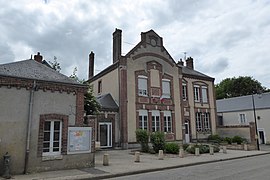
The siege of Orléans marked a turning point of the Hundred Years' War between France and England. The siege took place at the pinnacle of English power during the later stages of the war, but was repulsed by French forces inspired by the arrival of Joan of Arc. The French would then regain the initiative in the conflict and began to recapture territories previously occupied by the English.
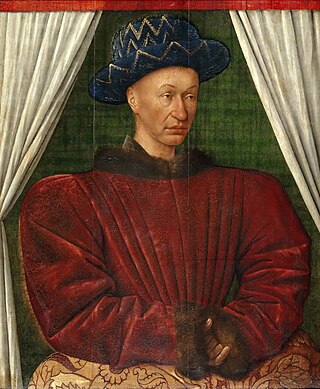
Charles VII, called the Victorious or the Well-Served, was King of France from 1422 to his death in 1461. His reign saw the end of the Hundred Years' War and a de facto end of the English claims to the French throne.
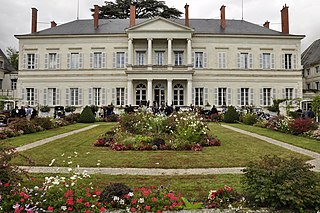
Loir-et-Cher is a department in the Centre-Val de Loire region of France. Its name is originated from two rivers which cross it, the Loir in its northern part and the Cher in its southern part. Its prefecture is Blois. The INSEE and La Poste gave it the number 41. It had a population of 329,470 in 2019.

Eure-et-Loir is a French department, named after the Eure and Loir rivers. It is located in the region of Centre-Val de Loire. In 2019, Eure-et-Loir had a population of 431,575.

Loiret is a department in the Centre-Val de Loire region of north-central France. It takes its name from the river Loiret, which is contained wholly within the department. In 2019, Loiret had a population of 680,434.

Chartres is the prefecture of the Eure-et-Loir department in the Centre-Val de Loire region in France. It is located about 90 km (56 mi) southwest of Paris. At the 2019 census, there were 170,763 inhabitants in the metropolitan area of Chartres, 38,534 of whom lived in the city (commune) of Chartres proper.

The Carnutes or Carnuti, were a Gallic tribe dwelling in an extensive territory between the Sequana (Seine) and the Liger (Loire) rivers during the Iron Age and the Roman period.

Châteaudun is a commune in the Eure-et-Loir department in northern France. It is a sub-prefecture of the department. It was the site of the Battle of Châteaudun during the Franco-Prussian War.

Perche is a former province of France, known historically for its forests and, for the past two centuries, for the Percheron draft horse breed. Until the French Revolution, Perche was bounded by four ancient territories of northwestern France: the provinces of Maine, Normandy, and Orléanais, and the region of Beauce. Afterwards it was absorbed into the present-day departments of Orne and Eure-et-Loir, with small parts in the neighboring departments of Eure, Loir-et-Cher, and Sarthe.

The Battle of Meung-sur-Loire took place on 15 June 1429. It was one of Joan of Arc's battles following relief of the siege at Orléans. This campaign was the second sustained French offensive in a generation in the Hundred Years' War.
Moulhard is a commune in the Eure-et-Loir department in northern France.
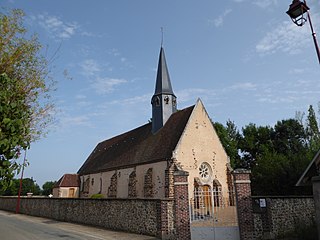
Saint-Denis-des-Puits is a commune in the Eure-et-Loir department and Centre-Val de Loire region of north-central France. It lies 24 km west-south-west of Chartres and around 100 km from Paris.

Toury is a commune in the Eure-et-Loir department in northern France. Toury station has rail connections to Orléans, Étampes and Paris.

Neung-sur-Beuvron is a commune in the Loir-et-Cher department, in the administrative region of Centre-Val de Loire, France.
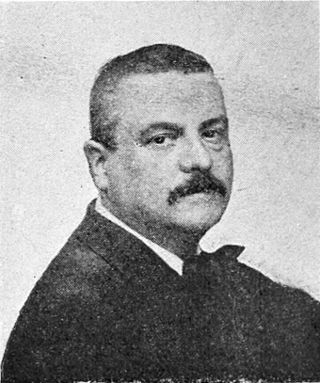
Lionel-Noël Royer was a French painter. He was most famous for painting large scenes of the life of Joan of Arc in the Basilica of Bois-Chenu in Domrémy.

The Armée de la Loire was a French army of the Franco-Prussian War. It was formed in October 1870 by Léon Gambetta, interior minister and minister for war in the Government of National Defence, then taking refuge in Tours after the French defeat at Sedan on 2 September 1870 had destroyed the Imperial field army. The newly raised force was formed out of francs-tireurs, provincial Gardes Mobiles (territorials), naval forces, zouaves and tirailleurs from Algeria, plus regular soldiers in depots and reservists. Together these diverse units formed the 15th army corps under Joseph Édouard de la Motte Rouge. Apart from the North African units, the Army had few officers with fighting experience, insufficient artillery, and under-trained troops. It fought at the Battle of Orléans (1870) and Battle of Le Mans (1871) and was dissolved on 14 March 1871.

Thymerais is a natural region of Eure-et-Loir, in France, where history and geography meet. Open to influences from Normandy, Drouais, Beauce and Perche, it is a transition zone like the Drouais.
The canton of Les Villages Vovéens is an administrative division of the Eure-et-Loir department, northern France. Its borders were modified at the French canton reorganisation which came into effect in March 2015. Its seat is in Les Villages Vovéens.

The Battle of Artenay' also known as the Battle of Arthenay, took place during the Franco-Prussian War, on 10 October 1870, in Artenay a small town located on the road from Orléans to Paris, France which was about 10 miles north of the city of Orléans. In this fierce battle, with superior strength compared to the opponent, The I Corps of the Kingdom of Bavaria, under the command of Lieutenant General Ludwig von der Tann-Rathsamhausen, in collaboration with the 22nd Division of the XI Corps of the Kingdom of Prussia and the two cavalry divisions of the Prussian army attacked and penetrated the defense system of the army of the Loire of the young French Republic, under the control of general Joseph Edouard de la Motterouge, causing heavy losses for the French military of which many people were taken prisoner. The winning conditions Artenay were favorable enough for Von der Tann to strike Orléans, while the forces of France knocked back on Orléans forest in an agitated state. Despite this, Nièvre's Garde Mobiles and the Pontifical Legion in the French army were noted for their strong resistance, while a monk in Prussian Cavalry under the command of Prince Albrecht demonstrated his prowess in the battle at Artenay.

Noël Parfait was a French writer, political activist and republican deputy.
